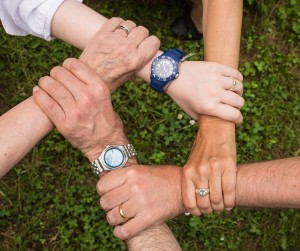Social Media is Bigger Than Marketing
- At January 15, 2020
- By rbadmin
- In Uncategorized
 0
0
The following headline in the Harvard Business Review no doubt left social media marketers clutching their pearls: “Social Media Is Too Important to Be Left to the Marketing Department.”
Obviously marketing departments run a business’s social media channels. Who else would do it? Engineering? Accounting?
It’s a different story, of course, if you run a small business and don’t even have a marketing department. You won’t have any departments, and you’ll probably manage your social media channels yourself—if you even have any.
But if you manage the social media channels at a large business, odds are good that you could use a little assistance from people in other departments, even if you don’t realize it or don’t want to admit it. Because the vast majority of messages that customers send to business through social media channels go unanswered. The majority!
Imagine if your customer service team answered only 1 in 8 emails right away, waited more than 3 days to get back with an answer or just flat out failed to pick up the phone 88% of the time. Unacceptable, right? Despite significant gains in the perception and value of social media, many brands remain unmoved in the quest to institute a fully functioning social communication strategy.
Not every message needs to be answered, of course. A Facebook comment isn’t always the social media equivalent of a help-desk ticket. Nor is every comment a complaint that needs to be dealt with. Some customers just want to say they love your latest widget release. Still, almost half of customer messages do require some kind of response, so if the vast majority end up in the bit bucket, you’re doing it wrong.
Then again, markers aren’t in customer service. They’re marketers. They have a different skillset and a different job description. Handling customer complaints isn’t what they signed up for, and it’s not what anyone really expects them to do.
Rather than fobbing off social media to customer service, marketers would be well advised instead to bring customer service and sales representatives in. Make the effort collaborative.
Here’s Harvard’s advice for creating a cross-functional team:
- Develop a social care team that can address all areas of social information efficiently and effectively. Identify policies and software systems needed for implementation.
- Organize departmental responsibilities in the social care team. Clearly define roles and responsibilities among marketing, customer service, public relations, sales, corporate communication, human resources, etc.
- Assign specific employees from each department to social media tasks. Set up social media accounts and give employees access to social media systems.
- Create brand guidelines for standards, tone, and style of social media communication. Ask legal and human resources to provide a list of do’s and don’ts for real-time consumer engagement.
- Define specific goals based on key performance indicators such as response time, sentiment analysis, engagement, views and shares, and other important metrics.
It’s a bit of an exaggeration to say that social media is too important to be left to the marketing department, but it is too important to be left to the marketing department alone.
How to Unlock Your Own Creative Genius in Thirty Minutes
- At January 06, 2020
- By rbadmin
- In Uncategorized
 0
0
If you’re feeling stuck creatively and can’t seem to come up with anything fresh, don’t worry. There’s a process for getting unstuck.
You know you’re supposed to brainstorm ideas. That’s obvious. But most people don’t know how to deep brainstorm and use creative persistence to punch through the creative blocks in their path.
Here’s how it works:
Start by brainstorm ten new ideas. It’s fine if you hate all of them. If you’re doing it right, you won’t use anything at of them on your list for your next project. This is a list of your weak ideas, the proverbial low-hanging fruit, the ones that aren’t likely to inspire you or anyone else.
Now brainstorm ten more ideas and write them down on a separate sheet of paper or in a different file. This list is probably better than the first. You probably had to stretch yourself a bit. You’re less likely to add clichés to this list since you’ve gotten those out of the way. Chances are that at least one idea on your second list beats every single thing on your first list.
Now it’s time to set this list aside and create a third, and this time there’s no upper limit. Write down everything you can think of until your well is totally dry. Now you have a decent brainstorm list that you can work from, and it’s probably better than anything you thought you could come up with.
Feel free to stop at this point. By going through three iterations, you’ve probably unblocked yourself. But if you’re feeling ambitious, if you want to come up with something truly original that no one else in the world might have thought of yet, stretch yourself and create a fourth separate list.
That fourth list is where your creative genius will appear.
“Giving up is the enemy of creativity,” Brian Lucas and Loran Nordgren wrote in the Harvard Business Review.
They know because they ran some experiments on students and proved that their test subjects drastically underestimated how many ideas they could think of. The students’ assignment seemed straightforward and easy. All they had to do was spend ten minutes writing down every Thanksgiving dish they could think of in ten minutes. Then they were asked how many more dishes they thought they could think of it they were given an additional ten minutes.
The average student assumed they’d be able to think of ten additional dishes—one per minute—but they actually thought of fifteen more. Researchers had similar results when they asked comedians how many punch lines they could come up with.
But there’s more to this story than the well-known fact that people tend to underestimate themselves.
After each study we asked a separate group of people to rate the creativity of the participants’ ideas. Across the majority of our studies we found that ideas generated while persisting were, on average, rated to be more creative than ideas generated initially. Not only did participants underestimate their ability to generate ideas while persisting, they underestimated their ability to generate their most creative ideas.
So don’t stop just when you think you’ve unblocked yourself and have a good enough working list of ideas. That’s precisely the moment when you really ought to keep digging. Genius lurks in your subconscious. Go forth and find it.
Generations Are Not Marketing Segments
- At December 20, 2019
- By rbadmin
- In Uncategorized
 0
0
For decades, large companies have been advertising and marketing to their customers based on age group. “Young people” were perceived, or at least treated, as a monolith, as were senior citizens. Chief marketing officers obsessed over how to market to Millennials—as if 83 million Americans were more or less interchangeable and mostly wanted the same things.
None of this makes any sense any more, especially not in the era of targeted ads. Even the smallest businesses can take advantage of microtargeting. A self-published author of a science-fiction trilogy can advertise books to Star Wars and Star Trek fans, for example, regardless of the fans’ age, gender, or location. A vegan restaurant in Minneapolis, a boutique coffeeshop in Seattle, and a microbrewery in Portland can likewise microtarget its potential customer base.
The world is more culturally diverse than ever, with myriad “tribes” of athletes, hipsters, vegans, the religiously devout, bookworms, audiophiles, nature lovers, car guys, gym rats, running enthusiasts, wine connoisseurs—you name it. A single city block can include one of each type of person. Each member of each “tribe” has something meaningfully (not just commercially) in common with other members of their tribe on the other side of the world—including those who are decades older and of the opposite gender—that they don’t have in common with the person living next door.
Marketing to microsegments wasn’t possible decades ago and was only faintly possible until recently until the Internet simultaneously fragmented and (in different ways) brought people together.
So unless you’re selling school supplies or condos in retirement communities, forget marketing to strictly to age groups like Generation Z or Baby Boomers. Forget marketing to Millennials. What a Millennial, anyway? Someone who graduated from high school between the year 2000 and now. Sure, these folks have some things in common with each other that they don’t have with older and younger generations—bonds forged by shared experiences at a certain age during a certain moment in history—but a young twenty-something finance professional in Manhattan has little else in common with someone the same age born and raised by farmers in North Dakota.
Splitting your marketing segments into tribes is about more than just microtargeting your social media ads. Netflix, for instance, curates content for what it calls “taste communities.” And Netflix has identified more than a thousand of them. Obviously, with such a large number, the company is dividing its audience into more granular segments than those who like comedies versus those who like crime dramas. Netflix can actually determine if you’re the type of viewer who would enjoy American Horror Story with the latest Adam Sandler comedy as a chaser.
Businesses need to spend a lot more time thinking about how to market to people who like the same things and have a similar mindset. Easier said than done, of course, but you don’t want your business to be the last one on the bandwagon.
Nine Reasons Your Business Needs a Copy Editor
- At April 08, 2019
- By rbadmin
- In Uncategorized
 0
0
Every writer in the world needs a copy editor. Best-selling novelists, newspaper columnists, corporate communications pros—everybody. Even editors need a second set of professional eyes on their work.
Copy editing involves much more than fixing typos at the last minute. That’s the proofreader’s job, though proofreading can be rolled into copy editing. In addition to correcting spelling, punctuation, and grammar mistakes, copy editors improve the style and clarity of language, clean up awkward phrasing, remove redundant material, ask for additional details as needed, and improve the overall flow. They ensure your material is logical, consistent, and persuasive, and that one thing naturally follows another. In short, they ensure that what you’ve produced is as professional as it possibly can be.
Although every newspaper, magazine, and publishing company in the United States employs in-house or freelance copy editors, many businesses think they don’t have to—even though copy editing adds relatively little to the marketing and communications budget.
Here are nine reasons why businesses should reconsider:
- Your content isn’t ready yet. Skipping the editorial process and pressing publish too soon is the communications equivalent of flying an airplane without a safety inspection. Every error reduces customer confidence in your business, and glaring errors can shatter it.
- You need a professional pair of eyes. No writer on earth can edit their own work—including your staff writers. Since you wouldn’t ask someone who isn’t an accountant to double-check your taxes, or someone who isn’t a lawyer to look over your legal brief for mistakes, it’s best to hire a professional who is trained to spot errors and knows how to fix them.
- You need an objective, unbiased perspective. Colleagues won’t hesitate to point out a missing comma or misspelled word (if they’re sharp enough to spot them), but they may be too shy to say an entire paragraph needs to be rewritten from scratch.
- You need an external viewpoint. Someone who is unfamiliar with your business, or at least less familiar than those who work there every day, will know right away if you aren’t explaining yourself properly to people outside your organization.
- You need a technical and corporate translator. All businesses need someone who can convert technical and corporate jargon into standard English that their customers can easily understand and relate to.
- You’re too close to your own work. You know what you’re trying to say. That doesn’t mean everyone else will.
- You can’t afford to embarrass yourself. You can only make one first impression, and you don’t want to embarrass yourself by publishing errors that a professional can easily fix.
- You deserve the best possible product. A professional editor will do more than just fix your mistakes; he or she can dramatically improve the content of your writing, raising the quality of your entire organization’s output.
- Your writers will improve. Regular editorial feedback is akin to ongoing professional development. Your writers will never stop needing an editor, but they’ll produce better and better content over time.
The editorial staff at reddbug have helped clients like Adobe, Microsoft, and Amazon take their content to the next level. Contact us if you’d like our help. We can even provide a free sample edit. We hope to hear from you soon.
The Long Road Toward Mastery
- At November 02, 2018
- By rbadmin
- In Uncategorized
 0
0
“Mastery is not a function of genius or talent, it is a function of time and intense focus applied to a particular field of knowledge.” – Robert Greene
Those of us in creative professions—writers, graphic designers, computer programmers, artists of every variety—often feel like we’re not good enough. We compare our work to others’ and to the chimerical notions of perfection we have in our heads.
The more we learn, the more skills we develop, the more we realize what we don’t know and how far we still have to go.
It’s okay. It’s part of the package, and the feeling never truly goes away unless we give up.
In his book, Outliers, Malcolm Gladwell argues that it takes roughly 10,000 hours of dedicated practice to achieve proficiency in a difficult skill such as playing a musical instrument. That’s the equivalent of working 40 hours a week for five years.
Raymond Chandler used to tell young writers that they had to write a million words of crap before they’d ever get anything published. That’s the equivalent of ten or more books.
Legendary animation director Chuck Jones went even further. To artists he said, “you’ve got a million bad drawings inside you and the sooner you get them out, the better.”
If it takes such an extraordinary amount of time and effort to reach even a basic level of competence, how long does it take to actually master this stuff?
As it turns out, true mastery of the most difficult crafts is impossible.
In his book, Mastery: The Keys to Success and Long-Term Fulfillment, George Leonard describes three types of people who take on long-term endeavors and fail—the Dabbler, the Obsessive and the Hacker.
The Dabbler begins with tremendous enthusiasm and is thrilled with his first burst of progress, yet he soon finds himself on a plateau where there is no apparent improvement. He soon moves on to something else.
The Obsessive wants results, and she wants them fast. She usually gets them fast, too, because she’s willing to pull out all the stops. Unlike her friend the Dabbler, when she finds herself on the plateau without any apparent improvement, she doubles down on her efforts. Her intense energy helps her persevere for a while, and she may rise a level or even two beyond the first plateau, but a leveling-off followed by a painful decline is all but inevitable in her future, and probably sooner rather than later.
Meanwhile, the Hacker doesn’t mind the plateau. He’s perfectly content coasting along indefinitely without even trying to improve as long as he performs well enough to make a living and without getting fired.
Then there is a fourth kind of person, the kind who willingly walks and vows to stay on an infinite road. She grinds it out day after day, week after week, month after month, year after year and decade after decade for the whole of her life. She spends nearly all her time on one plateau or another, but she improves by increments, and at times by leaps and bounds, with each plateau rising higher than the last. She never reaches the top—there is no top—but she produces a body of work over a lifetime that seemed unimaginable when she started.
Walking an infinite road can be intimidating at times, but ultimately it is liberating. You don’t have to keep asking yourself when you will finally get there because no final destination exists. The road toward mastery is longer than a human lifespan. No matter how far we walk or paddle or drive, the horizon remains in the distance.
“To love the plateau is to love the eternal now,” Leonard writes, “to enjoy the inevitable spurts of progress and the fruits of accomplishment, then serenely to accept the new plateau that waits just beyond them.”
Enjoy the journey.





